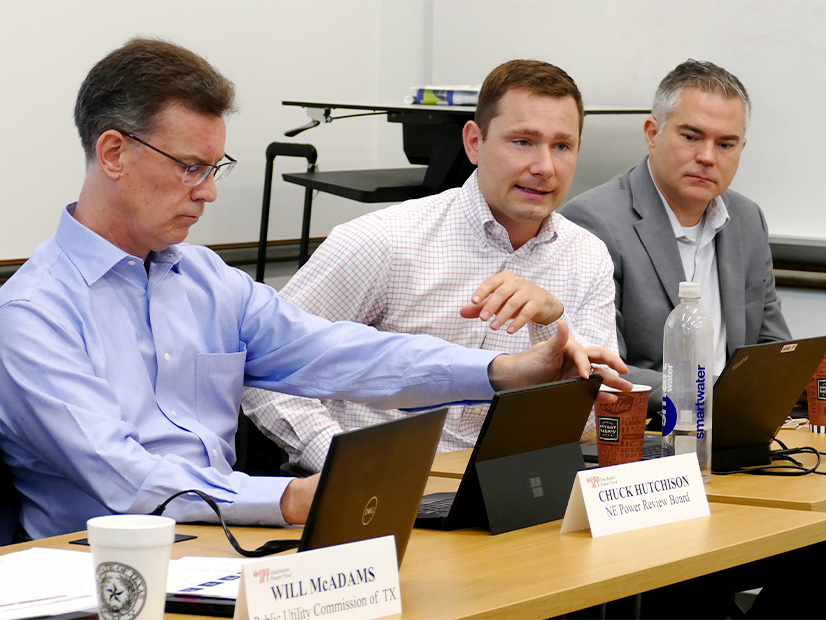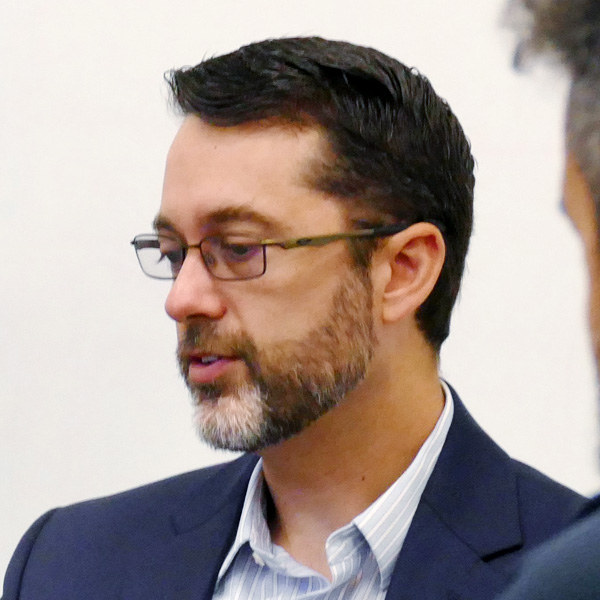
AUSTIN, Texas — Texas commissioner Will McAdams, chair of SPP’s Resource and Energy Adequacy Leadership (REAL) Team, set the tone from the outset when he shed his blazer and rolled up his sleeves as the group gathered for its meeting Wednesday.
“It’s July in Texas. Let’s get started,” he said.
For the next nine hours of what McAdams called a “crusher” of a meeting, the REAL Team discussed issues ranging from flexibility and ramp associated with capacity obligations to maintenance outages and their effect on capacity obligations. A central theme emerged around how SPP compensates load-responsible entities for availability or penalizes them for lack of availability during critical hours.
“It’s a lot of ships that we hope are moving in the same direction now, but it’s a lot to coordinate,” McAdams told fellow commissioners during an open meeting the following day.
The team met its first objective when it endorsed a winter resource adequacy requirement (RAR) approved recently by the RTO’s Markets and Operations Policy Committee. The revision request (RR549) will go before SPP’s state regulators and its Board of Directors this week for final consideration. (See “Members Endorse Winter Resource Adequacy Requirement for 2024-25,” SPP Markets and Operations Policy Committee Briefs: July 10-11, 2023.)
The measure applies the same level of validation, study and assessment requirements to the winter season (December through March) that is applied to the summer season, including a deficiency payment for capacity shortfalls. It also assigns an annual deficiency payment to prevent duplicate payments for the same capacity within an annual timeframe.
RR549 is not without its detractors. It barely met MOPC’s approval threshold and cleared the REAL Team with two votes to spare, 9-5. Members removed one of two revisions added during the MOPC discussion over confidentiality concerns.
The measure is effective for the 2024/25 winter season (December through March).
“It was a hairy deal,” McAdams told the Texas Public Utility Commission. “It’s a real shootout. Just trying to provide the mechanisms that ensure resource adequacy is not an easy thing. These are not easy decisions.”
SPP’s board and state regulators created the REAL Team, comprised of 14 independent directors, members, and regulators and their staff, earlier this year. The team has been meeting every three weeks since May. (See SPP’s REAL Team Swings Into Action.)
“I think the REAL Team is a bit of a fusion center,” McAdams told RTO Insider after the team’s first in-person meeting in May. “It’s bringing together corporate members, components of the Members Committee, the stakeholder components of SPP together with [Regional State Committee] leadership as well as board leadership … so that topics can be flagged and, frankly, polled to a degree in terms of resistance to certain staff recommendations and or support.”
The team has created sub-groups focused on resource adequacy, markets and operations. They will lean heavily on the Supply Adequacy Working Group (SAWG), which has primary responsibility for nine of the 11 objectives assigned to the REAL Team.
Its next milestone comes in October, when it plans to consider a ramping capacity requirement, begin addressing the footprint’s need for reliability attributes in the resource mix and endorse tariff changes — RR554 and RR568, respectively — that codify performance-based accreditation (PBA) and effective load carrying capacity (ELCC) policies.
The SAWG is developing both tariff revisions. It has created limitations for catastrophic exemptions that apply to all resource types that will sunset after 10 years of historical data from the units. The working group also has simplified the ELCC tiers by using a two-tiered approach with firm and non-firm transmission service.
More important, the SAWG has prepared a system methodology for upcoming loss-of-load expectation and ELCC studies that evaluates the collective reliability contribution of all ELCC resources to ensure they are correctly accredited.
SPP is responding to FERC’s recent order admitting it had mistakenly approved the RTO’s proposal to use an ELCC methodology to accredit wind and solar resources based on historical performance. The commission has granted renewable developers a rehearing of its original order. (See FERC Grants Rehearing of SPP Capacity Accreditation Proposal.)
The grid operator’s Market Monitoring Unit said it had equity and accountability concerns over the PBA and ELCC. It recommended measuring individual performance in the PBA process against the top 3% net peak load and including all outages, whether forced maintenance or out-of-management control, in the accreditation processes.
The MMU offered two recommendations it said would improve reliability that left one commission staffer shaking his head: the PBA measurement against the top 3% net load and implementing a true-up process at the end of each season.
Keith Collins, vice president of market monitoring, shared an event his team picked up just before July 4, when SPP had issued a resource advisory and then a conservative operations call. He said the MMU became aware of several hundred megawatts of resources, accredited for the summer, that were on outages because of staffing issues.
“They were aware … that whatever they were going to do was going to be accounted for in performance-based accreditation, and they did it anyway,” Collins said. “If we want to think of the incentives and what we’re doing to keep people from making those decisions and contributing to a reliable system, particularly when we need it the most, then we’re not there yet — because they did it anyway.”
SPP’s continued integration of renewable resources over conventional or thermal resources has created operational uncertainty and shortened the staff’s ability to commit resources, according to C.J. Brown, director of system operations. On Sunday, the RTO issued a resource advisory because of high loads, load and variable energy forecast uncertainty, and resource outages; it is at least the sixth resource of conservative operations advisory SPP had called since April.
“Those are very challenging and stressful situations,” he said. “You feel like every one thing you give up could put you into a situation where you’re not able to cover a certain percentage of uncertainty. We have to do that leading up to and including real time, and that starts as much as seven days out. Typically, about four days out is our longest lead time when a decision has to be made, but that’s just a continual process these days.”
“Two years ago, we might have made that decision two or three times a year,” Brown added. “Now it seems like it’s every other week.”
To maintain current levels of capacity until sufficient resource adequacy measures are in place, staff are developing policies — likely including some form of system support resource or reliability must-run contracts used by other grid operators — that “strongly encourage” generation owners to reconsider and postpone retirements. Based on utilities’ integrated resource plans and information gleaned through the transmission process, SPP expects 6.5 GW of gas- and coal-fired resources to retire by 2030.
The problem is compounded by hints of reluctance from renewable developers about investing in an RTO where conventional resources are retained.
“What we’re hearing is some of the recommendations and activities we’re making in the SAWG space and in the REAL space might be shifting renewables to other more profitable regions,” Casey Cathey, senior director of grid asset utilization, told the REAL Team. “Are we defining the requirements at a razor’s edge to where we’re just maintaining the fleet and barely improving? I think we need more markets, we need more carrots to be able to better optimize over a longer time horizon so the LREs can kind of appreciate what kind of supply we actually better recognize … we want to make sure we’re sending the right signal that if we are retaining our conventional fleet, that we have a path forward, because right now it seems like there’s a whipsaw.”
SPP’s generator interconnection dashboard indicates solar resources account for 43% of the projects in the GI queue (45.6 GW of 105.5 GW), followed closely by wind (26.1 GW, 24.8%) and battery storage (19.9 GW, 18.8%). Cathey said solar requests exceeded those for wind for the first time earlier this year.
“We can’t wait [for the solar]. We’ve had 250 megawatts of installed solar for a long time, but we have just not seen that build,” he said. “We’ve been thinking for about six to seven years that this might be our next frontier. Wind is highly volatile, it can be helpful, but a lot of times when wind winds down, solar’s actually doing pretty good.”
Cathey said the potential 90 GW of solar, wind and batteries in the queue doesn’t give him “a lot of comfort,” however.
“If we installed all gigawatts of wind, solar and batteries and we also retired a good portion of our conventionals, we would still have C.J. describing some slides of some conservative operations, and so we need to be balanced here,” he said. “Hopefully, a lot of this gets built but we also need to make sure we’re sending the right signal to either keep resources, conventionals, online for a period of time until another technology can take over.”
RA Forum Draws Industry Interest
The REAL Team will hold its next in-person meeting Sept. 8 in Dallas, the day after SPP hosts a Resource Adequacy Summit at DFW International Airport.
What started as a meeting limited to 75 attendees has blown up into an industry event that has drawn the interest of at least two FERC commissioners, according to organizers. NERC’s and EPRI’s CEOs, Jim Robb and Arshad Mansoor, respectively, have accepted invitations.
“There’s heavy interest nationally to provide forums where the reliability standard concept can be discussed on a national basis, what that involves and what defines resource adequacy, not just within ISOs but regionally,” McAdams said.
SPP has extended invitations to its neighbors, with MISO already accepting. ERCOT also has been invited to attend.
Even without ERCOT, Texas will have a heavy presence. McAdams said PUC staff will attend and energy consulting firm E3 will discuss valuing availability. E3 proposed an LSE reliability obligation construct and several other market designs for the Texas grid operator following the disastrous and deadly 2021 winter storm.
SPP has secured a larger meeting space than originally planned to handle the increased attendance.




